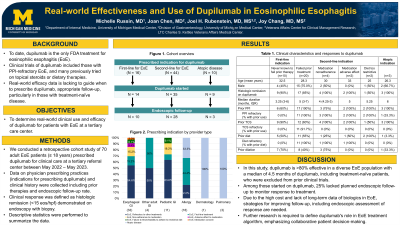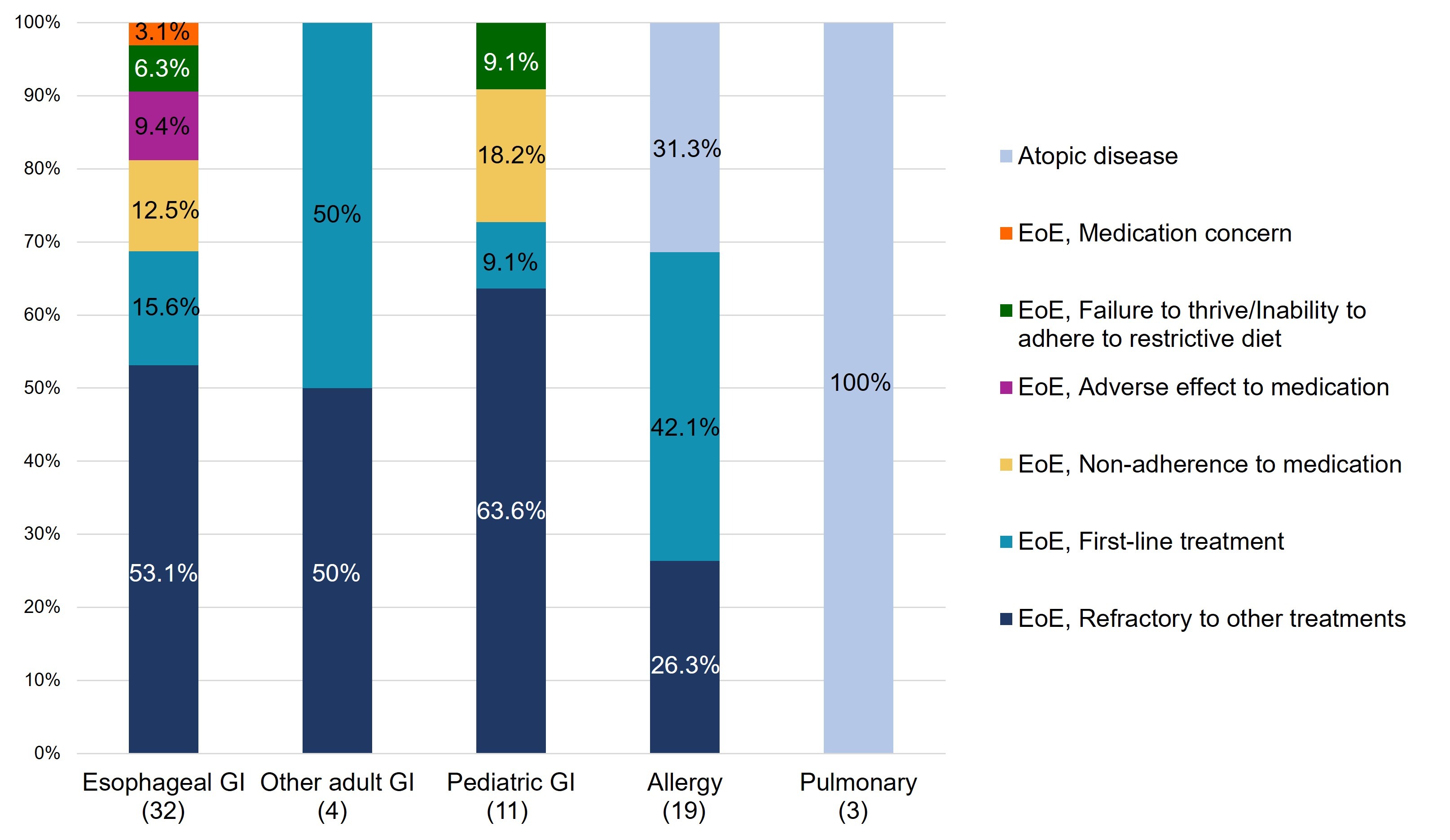Monday Poster Session
Category: Esophagus
P1836 - Real-World Effectiveness and Use of Dupilumab in Eosinophilic Esophagitis
Monday, October 23, 2023
10:30 AM - 4:15 PM PT
Location: Exhibit Hall

.jpg)
Joy W. Chang, MD, MS
University of Michigan
Ann Arbor, MI
Presenting Author(s)
Michelle Russin, MD, Joan W. Chen, MD, Joel H. Rubenstein, MD, MSCI, Joy W. Chang, MD, MS
University of Michigan, Ann Arbor, MI
Introduction: Dupilumab is currently the only FDA-approved treatment for eosinophilic esophagitis (EoE). Clinical trials included only PPI-refractory disease and the majority (70%) had previously tried diet or topical steroids. However, real world data on use and effectiveness, particularly in mild EoE, is lacking. We aimed to determine real-world effectiveness and characterize patients prescribed dupilumab for EoE.
Methods: We conducted a retrospective cohort study of EoE patients prescribed dupilumab for clinical care at a tertiary referral center from May 2022–2023. Patient demographics, clinical characteristics, and EoE treatment history were extracted from the medical record, including prior treatments, dilations, prescribing provider, dupilumab indication and duration, endoscopic follow-up, and histologic response (defined as < 15 eos/hpf).
Results: We identified 69 adult EoE patients (50.7% male; 91.3% white; mean age 31.6 years, SD 11.9) prescribed dupilumab – 60 (87%) for treatment of EoE, 9 (13%) for other atopic disease. Dupilumab was used as a first-line EoE treatment (no prior history of failing other therapies) in 16 (26.7%) patients, and as second-line in 44 (73.3%), with majority (70.5%) due to treatment refractory disease. Indications for dupilumab varied across provider types (Figure 1). Of those prescribed, 57 patients started dupilumab with median treatment time of 6 months (IQR 3.5-9). Endoscopy to monitor response occurred in 26 (45.6%) and another 21.1% have endoscopy planned; 33.3% of patients lack planned endoscopic follow-up. Peak eosinophil counts were significantly reduced after therapy (57.9 ± 5.4 vs 3.3 ± 1.1 eos/hpf, p< 0.001). Patients who were not treatment-refractory (i.e. no prior treatment failure, those nonadherent to or had adverse effects to prior therapies) achieved 100% histologic response to dupilumab. All but 1 patient refractory to standard treatments achieved remission.
Discussion: In our tertiary care practice, dupilumab is effective in >90% for a diverse EoE population including treatment-naïve patients, who were excluded from the phase 3 trial. Despite this, many lack endoscopic follow-up to monitor response. Due to the high cost and current lack of long-term side effect data on biologic therapies for EoE, strategies for improving follow-up after treatment initiation are needed. Future comparative and cost effectiveness studies are needed to understand how dupilumab fits into the current treatment paradigm.

Disclosures:
Michelle Russin, MD, Joan W. Chen, MD, Joel H. Rubenstein, MD, MSCI, Joy W. Chang, MD, MS. P1836 - Real-World Effectiveness and Use of Dupilumab in Eosinophilic Esophagitis, ACG 2023 Annual Scientific Meeting Abstracts. Vancouver, BC, Canada: American College of Gastroenterology.
University of Michigan, Ann Arbor, MI
Introduction: Dupilumab is currently the only FDA-approved treatment for eosinophilic esophagitis (EoE). Clinical trials included only PPI-refractory disease and the majority (70%) had previously tried diet or topical steroids. However, real world data on use and effectiveness, particularly in mild EoE, is lacking. We aimed to determine real-world effectiveness and characterize patients prescribed dupilumab for EoE.
Methods: We conducted a retrospective cohort study of EoE patients prescribed dupilumab for clinical care at a tertiary referral center from May 2022–2023. Patient demographics, clinical characteristics, and EoE treatment history were extracted from the medical record, including prior treatments, dilations, prescribing provider, dupilumab indication and duration, endoscopic follow-up, and histologic response (defined as < 15 eos/hpf).
Results: We identified 69 adult EoE patients (50.7% male; 91.3% white; mean age 31.6 years, SD 11.9) prescribed dupilumab – 60 (87%) for treatment of EoE, 9 (13%) for other atopic disease. Dupilumab was used as a first-line EoE treatment (no prior history of failing other therapies) in 16 (26.7%) patients, and as second-line in 44 (73.3%), with majority (70.5%) due to treatment refractory disease. Indications for dupilumab varied across provider types (Figure 1). Of those prescribed, 57 patients started dupilumab with median treatment time of 6 months (IQR 3.5-9). Endoscopy to monitor response occurred in 26 (45.6%) and another 21.1% have endoscopy planned; 33.3% of patients lack planned endoscopic follow-up. Peak eosinophil counts were significantly reduced after therapy (57.9 ± 5.4 vs 3.3 ± 1.1 eos/hpf, p< 0.001). Patients who were not treatment-refractory (i.e. no prior treatment failure, those nonadherent to or had adverse effects to prior therapies) achieved 100% histologic response to dupilumab. All but 1 patient refractory to standard treatments achieved remission.
Discussion: In our tertiary care practice, dupilumab is effective in >90% for a diverse EoE population including treatment-naïve patients, who were excluded from the phase 3 trial. Despite this, many lack endoscopic follow-up to monitor response. Due to the high cost and current lack of long-term side effect data on biologic therapies for EoE, strategies for improving follow-up after treatment initiation are needed. Future comparative and cost effectiveness studies are needed to understand how dupilumab fits into the current treatment paradigm.

Figure: Figure 1. Prescribing indication by provider type
Disclosures:
Michelle Russin indicated no relevant financial relationships.
Joan Chen indicated no relevant financial relationships.
Joel Rubenstein indicated no relevant financial relationships.
Joy Chang: Sanofi-Regeneron – Consultant.
Michelle Russin, MD, Joan W. Chen, MD, Joel H. Rubenstein, MD, MSCI, Joy W. Chang, MD, MS. P1836 - Real-World Effectiveness and Use of Dupilumab in Eosinophilic Esophagitis, ACG 2023 Annual Scientific Meeting Abstracts. Vancouver, BC, Canada: American College of Gastroenterology.
